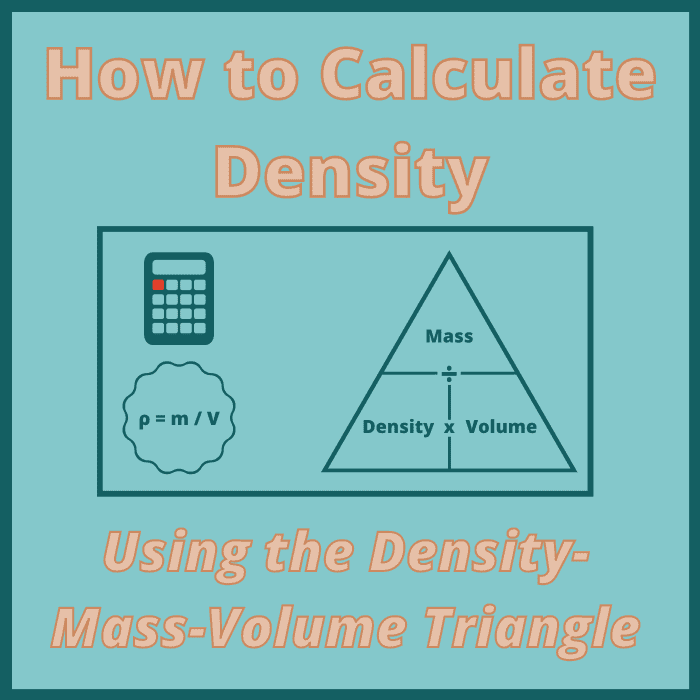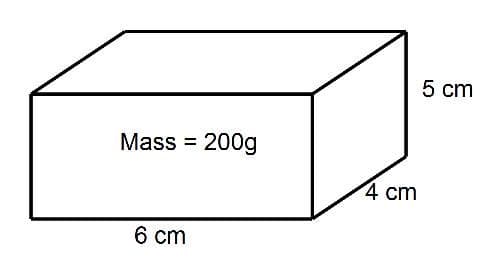How To Find Mass If Volume And Density Are Given
Marking, a math enthusiast, loves writing tutorials for stumped students and those who need to castor upwards on their math skills.

Learn how to calculate the density, mass, or volume of a solid object using this handy visual tool.
Canva
What Is Density?
Density is a measure out of how compact (dense) an object is. If an object has a greater density than water, the object will sink in water. If it has a lower density than water, information technology will float.
How Practise You Work Out the Density of a Solid Object
To calculate an object's density, nosotros'll need to know the object's mass and book. We can then plug those values into the following equation to calculate the object's density:
Density = Mass / Volume
This formula is often written using the following symbols:
- ρ: density
- m: mass
- V: book
Using these symbols as variables, our formula at present looks like this:
ρ = 1000 / 5

The mass-density-volume triangle helps us visualize the relationships between these three variables.
Canva
What Is the Density-Mass-Volume Triangle?
The density-mass-volume triangle (pictured to a higher place) is a visual tool that we tin can use to figure out how to calculate the density, mass, or book of a solid object if nosotros know the two remaining values. The triangle is divided into three parts, with density occupying the top portion and mass and volume occupying the bottom two portions.
The positions of each element of the triangle show united states of america how they relate to one another through the formula in a higher place (Density = Mass / Volume, or ρ = 1000 / V).
How to Calculate Density
If we desire to calculate density, nosotros merely cover upwardly density in the triangle and see what remains. Since mass is above volume, we divide mass by volume to go density.
Density = Mass / Book
ρ = m / Five
How to Summate Mass
If we want to summate mass, we simply embrace up mass in the triangle and see what remains. Since density and book are adjacent, we multiply density by volume to get mass.
Mass = Density * Book
m = ρ * 5
Read More From Owlcation
How to Summate Volume
If we want to summate volume, we simply encompass up volume in the triangle and encounter what remains. Since mass is above density, we split up mass by density to get volume.
Volume = Mass / Density
V = m / ρ
Example Bug With Processes and Solutions
Let's take a wait at some example problems and solve them using the density-mass-volume triangle explained above.

In this kickoff example, we need to calculate the density of this rectangular prism, or cuboid.
Instance ane
A solid rectangular box has a length of 6 cm, a width of 4 cm, and a superlative of five cm. Work out the density of the box if the mass of the box is 200 g.
This question asks united states of america to piece of work out the density. Therefore, we'll need the formula for density (Density = Mass / Volume).
However, the question states the mass of the box simply doesn't state the volume, so nosotros'll need to work out the volume of the box before we tin can work out the density.
Since the box is a cuboid, the volume can be constitute past multiplying lengths of the three side lengths together:
Volume = Length * Width * Elevation
Five = 6 * 4 * 5
V = 120 cm³
Now that we have the volume, the density tin can be calculated:
Density = Mass / Volume
ρ = thou / Five
ρ = 200 / 120
ρ = i.67 grand/cm³

In this 2d example, nosotros demand to calculate the mass of this triangular prism.
Case 2
Work out the mass of this triangular prism if the density is iii g/cm³.
This time, we are asked to work out the mass, so we'll need the formula for mass (Mass = Density * Volume).
In this question, we are given the density just non the volume, so let's begin past calculating the book of the triangular prism. The cantankerous sectional surface area of the prism can be found by using the formula Area = ½ * (Base * Elevation).
A = ½ * (6 * eight) = 24 cm²
The volume of the prism can at present be found by multiplying this area past the length:
ρ = 24 * 15
ρ = 360 cm³
Now that we have the volume, nosotros can work out the mass of the triangular prism:
Mass = Density * Volume
m = ρ * V
m = 3 * 360
m = 1080 yard (or 1.08 kg)
This content is accurate and true to the best of the author's knowledge and is not meant to substitute for formal and individualized advice from a qualified professional.
Questions & Answers
Question: A container is a rectangular prism. Its dimensions are l cm X 40 cm X 10 cm. If it filled with h2o, what is the mass of the h2o?
Answer: First, work out the volume of the rectangular prism by multiplying the 3 dimensions together, l multiplied past 40 multiplied by x to give twenty,000 cm^3. Now since 1cm^3 is the same as 1g of water the answer is xx,000g (or 20kg).
Question: How much mass in rectangular prism summit of 100 and a length of 25 and width of 3?
Answer: First find the volume by multiplying the numbers together to give 7500. Now multiply this answer past the density of the rectangular prism to give the mass.
Question: How exercise y'all summate the density of a cube?
Answer: Kickoff work out the volume of the cube past cubing the side length.
And so separate the mass (given in the question) by the book.
Question: What is density?
Answer: Density tin can exist worked out past dividing the mass by the book.
Question: A wooden block is a rectangular prism. Its length is 8 cm, the length of one of the ii perfect square sides is ii cm, the mass of the wooden block on the electronic balance reads 150 grams, what is the density of the wooden block?
Answer: First work out the volume of the block which is 32 cm^three (8 times 2 times 2).
And so divide 150 by 32 to give 4.6875 g/cm^3
Source: https://owlcation.com/stem/The-Density-Mass-and-Volume-Magic-Triangle-How-to-calculate-density-of-a-solid-shape-Math-Help
Posted by: hensonforgageds.blogspot.com


0 Response to "How To Find Mass If Volume And Density Are Given"
Post a Comment